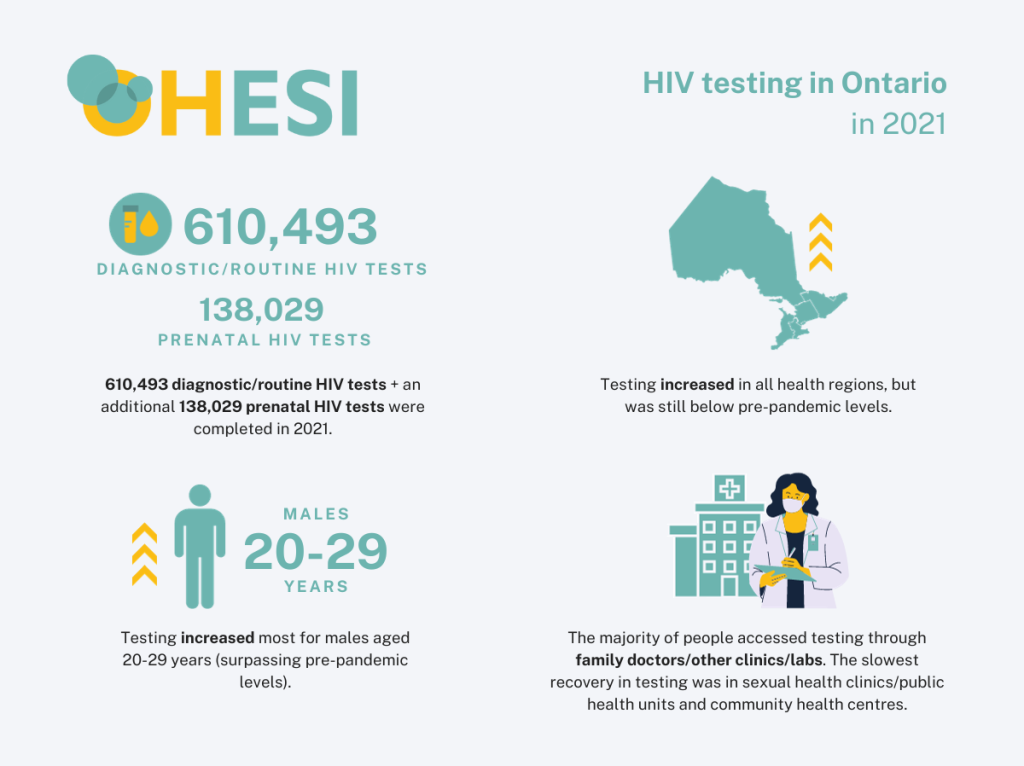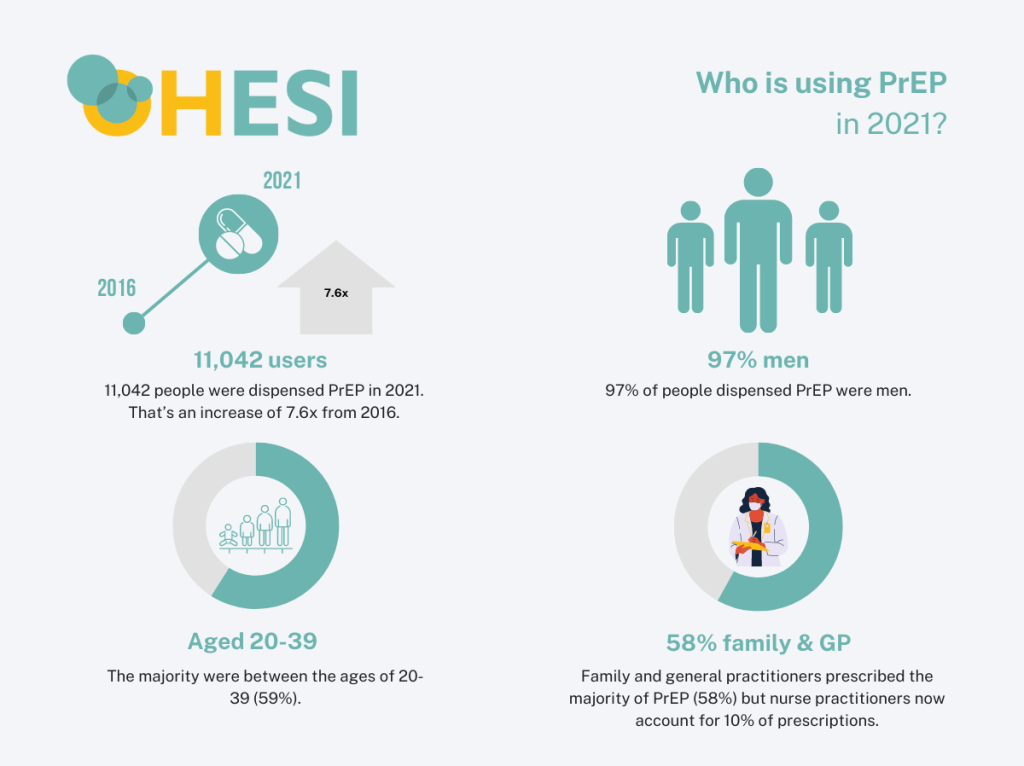Dec 1st, 2023
Trends in HIV testing, diagnoses and the care cascade in Ontario in 2022
OHESI releases this blog post in recognition of World AIDS Day 2023. This year, the theme for the day is “Let Communities Lead”. According to UNAIDS, “This World AIDS Day is more than a celebration of the achievements of communities; it is a call to action to enable and support communities in their leadership roles.” We acknowledge the role of community in OHESI’s efforts, especially the OHESI Champions Committee. Our committee members shape our understanding and interpretation of data, and help ensure that the information we produce can be put into action. As we enter the post-COVID19-pandemic world, it is critical to monitor the epidemic with community guidance, in order to best understand HIV transmission and the HIV care cascade in Ontario.
HIV testing almost reaching pre-COVID19-pandemic levels
- After a significant (25%) drop in HIV testing at the height of the COVID-19 pandemic (2020), the number of tests continued to recover in 2022. The total number of HIV tests (excluding prenatal tests) in 2022 increased by 5.1% (641,745) compared to 2021 (610,511), but remained 5.2% lower than the 10-year high in 2019 (677,243).
- HIV tests (excluding prenatal tests) were up in both males and females compared to 2020 and 2021, but still below pre-pandemic levels.
- The number of unique pregnant people who received a prenatal HIV test as part of the Prenatal HIV Testing Program was 128,824 in 2022.
Figure 1: Number of HIV diagnostic tests (excluding prenatal tests) in Ontario, among males and females, 2013 to 2022

First-time HIV diagnoses following pre-pandemic trends
- There were 900 positive HIV tests in 2022 – 623 first-time HIV diagnoses and 277 diagnoses with previous evidence of HIV.
- Of the 623 first-time HIV diagnoses in 2022 – 449 were among males and 165 were among females.
- The number of first-time HIV diagnoses decreased by 13% in males between 2019 (514) and 2022 (449) and remained unchanged among females between 2019 (167) and 2021 (165) – and is reflected in the decreased test positivity in 2022 among males and increased test positivity among females compared to 2019.
- The number of positive HIV tests in persons with previous evidence of HIV dropped by over half in 2020 and 2021 compared to 2019 – likely due to fewer people already diagnosed with HIV moving to Ontario and entering care during the height of the COVID-19 pandemic. However, the number of positive HIV tests with previous evidence of HIV in 2022 was comparable to 2019.
Figure 2: Number of first-time HIV diagnoses and positive tests in persons with previous evidence of HIV, in Ontario, 2018 to 2022

Figure 3: Number of first-time HIV diagnoses among males and females, in Ontario, 2017 to 2022

Some key populations saw a drop in first-time HIV diagnoses between 2019 and 2022
From the beginning of the HIV epidemic, Ontario recognized that certain populations – defined by sexual identity, demographic characteristics (including country of birth and race/ethnicity), behaviour or social/systemic factors – bore a disproportionate burden of HIV. To reduce HIV transmission and improve health outcomes, Ontario’s HIV response has focused on these “key” populations, which include: gay, bisexual and other men who have sex with men (GBMSM); African, Caribbean and Black people (ACB), people who use injection drugs (PWID); Indigenous Peoples, and women who face systemic risks. We acknowledge that social and systemic factors can be critical drivers of the epidemic in these populations.
Key populations are not mutually exclusive and therefore a diagnosis from a single individual can be assigned to more than one population. However, when we examine first-time HIV diagnoses that could be assigned to one or more key populations (71% in 2022), we see that:
- Gay, bisexual, and other men who have sex with men (GBMSM) continue to account for the greatest number of first-time HIV diagnoses; however, there was a large decrease in first-time HIV diagnoses in 2022 (204) compared to 2019 (306). This decrease is likely due in part to a true drop in new infections (less transmission), owing to a more than doubling in the number of Ontarians on HIV pre-exposure prophylaxis (PrEP) between 2018 and 2022 (forthcoming PrEP report; OHTN), the majority (98%) of which are males and a large proportion of those males identifying as GBMSM.
- Males and females who are African, Caribbean and Black (ACB) saw no change in the number of first-time HIV diagnoses in 2022 compared to 2019.
- Males and females who use injection drugs saw a decrease in the number of first-time HIV diagnoses in 2022 compared to 2019.
- Indigenous females saw a stabilization in first-time HIV diagnoses in 2022 compared to 2019 while Indigenous males saw a decrease.
Figure 4: Number of first-time HIV diagnoses by key population, males in Ontario, 2019 versus 2022

Figure 5: Number of first-time HIV diagnoses by key population, females in Ontario, 2019 versus 2021

Toronto had the highest number of first-time HIV diagnoses while South West Region saw the largest decline compared to 2019
- South West, Toronto and Northern regions had fewer first-time HIV diagnoses in 2022 than in 2019
- While Toronto continued to have the highest number of first-time HIV diagnoses, that number was down 26.4% compared to 2019. South West Region saw a relative decrease of 33.3% while the Northern region saw a relative decrease of 7.1%.
- Eastern and Central West regions saw the largest relative increase in first-time HIV diagnoses between 2019 and 2022 (46.2 and 46.8%, respectively), while Ottawa saw a 32.4% increase and Central East a 12.4% increase.
Figure 6: Number of first-time HIV diagnoses, 2019 and 2022, by Ontario region

HIV Care Cascade for Ontario in 2022
In 2022, an estimated 20,855 people living with HIV knew their HIV status (i.e. were diagnosed). 18,457 people were in care, 17,910 people were on antiretroviral treatment (ART), and 17,587 people were virally suppressed (<200 copies/ml). Among the total number of people diagnosed with HIV in Ontario in 2022, 88.5% were in care, 85.9% were on ART and 84.3% were virally suppressed. Compared to 2019, the proportion in care remained he same and the proportion on ART and virally suppressed improved slightly.
NOTE: These proportions are not the UNAIDS 95-95-95 target metrics. Each metric is divided by the number of people diagnosed with HIV.
Figure 7 Number of people living with HIV who are diagnosed in Ontario engaged in the steps of the care cascade in 2022

Figure 8 Percent of people living with diagnosed HIV in Ontario engaged in the care cascade in 2022

Stay tuned for more OHESI reports coming soon! For a more detailed analysis of trends, see the forthcoming 2022 HIV Testing, Diagnosis and Care Cascade reports. The most recent reports on HIV diagnoses and testing can be found here.






